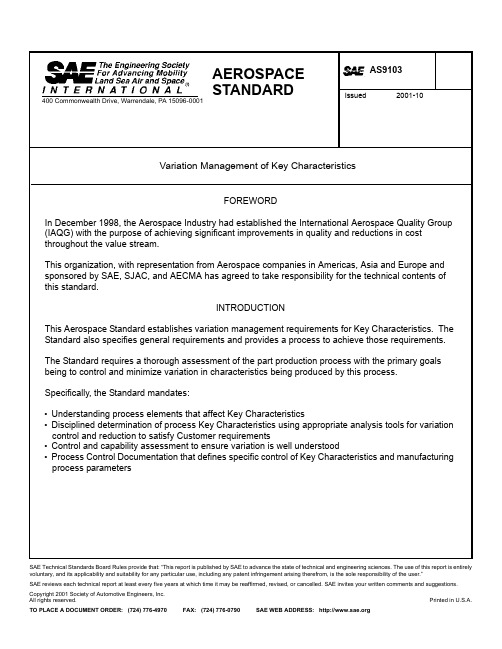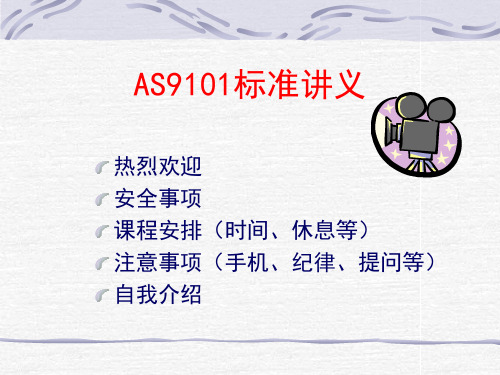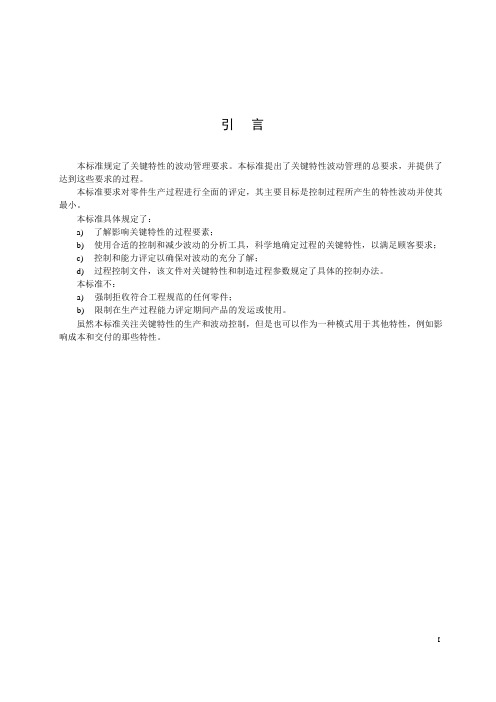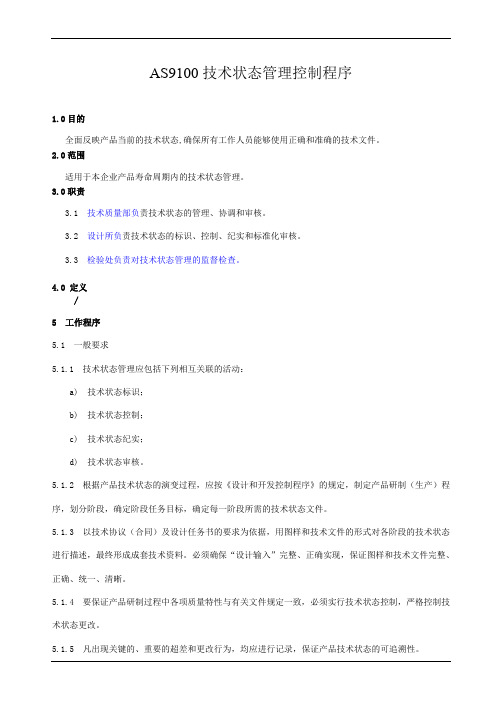AS9103_关键特性的波动管理要点
- 格式:doc
- 大小:126.50 KB
- 文档页数:13

SAE Technical Standards Board Rules provide that: “This report is published by SAE to advance the state of technical and engineering sciences. The use of this report is entirely voluntary, and its applicability and suitability for any particular use, including any patent infringement arising therefrom, is the sole responsibility of the user.”SAE reviews each technical report at least every five years at which time it may be reaffirmed, revised, or cancelled. SAE invites your written comments and suggestions.Copyright 2001 Society of Automotive Engineers, Inc.All rights reserved.Printed in U.S.A.TO PLACE A DOCUMENT ORDER: (724) 776-4970 FAX: (724) 776-0790 SAE WEB ADDRESS: 400 Commonwealth Drive, Warrendale, PA 15096-0001AEROSPACE STANDARD AS9103Issued 2001-10Variation Management of Key CharacteristicsFOREWORDIn December 1998, the Aerospace Industry had established the International Aerospace Quality Group (IAQG) with the purpose of achieving significant improvements in quality and reductions in costthroughout the value stream.This organization, with representation from Aerospace companies in Americas, Asia and Europe andsponsored by SAE, SJAC, and AECMA has agreed to take responsibility for the technical contents ofthis standard.INTRODUCTIONThis Aerospace Standard establishes variation management requirements for Key Characteristics. The Standard also specifies general requirements and provides a process to achieve those requirements.The Standard requires a thorough assessment of the part production process with the primary goalsbeing to control and minimize variation in characteristics being produced by this process.Specifically, the Standard mandates:•Understanding process elements that affect Key Characteristics•Disciplined determination of process Key Characteristics using appropriate analysis tools for variation control and reduction to satisfy Customer requirements•Control and capability assessment to ensure variation is well understood•Process Control Documentation that defines specific control of Key Characteristics and manufacturing process parametersThis standard does not:•Mandate rejection of any part that conforms to engineering specification.•Inhibit shipment or use of product during production process capability assessment.Although Aerospace Standard AS9103 is focused on production and variation control of Key Characteristics, this process can also be used as a model for other characteristics, such as those that affect cost and delivery.TABLE OF CONTENTS1.SCOPE (4)1.1Purpose (4)1.2Convention (4)2.REFERENCES (4)3.DEFINITIONS (5)4.APPLICABILITY (6)5.GENERAL REQUIREMENTS (6)6.PROCESS REQUIRMENTS AND OUTPUTS (8)APPENDIX A GUIDELINES TO MEETING REQUIREMENTS FOR VARIATIONMANAGEMENT OF KEY CHARACTERISTICS (10)APPENDIX B PROCESS CONTROL DOCUMENT EXAMPLE (14)1.SCOPE:This Standard is primarily intended to apply to new parts, but can also be applied to parts currently in production. The Standard shall be applicable to all production processes that influence the variation of Key Characteristics.1.1Purpose:This Aerospace Standard is designed to drive the improvement of manufacturing processes through adequate planning and effective management of Key Characteristic variation. The KeyCharacteristic focus is intended to improve confidence for part features whose variation has asignificant influence on to end-product form, fit, performance, service life and manufacturability.1.2Convention:The following conventions are used in this standard:•The words shall, will or must indicate mandatory requirements.•The word “should” indicates a requirement with some flexibility allowed in compliancemethodology. Producers choosing other methods to satisfy a “should” must be able to show that their approach meets the intent of the requirements of this standard.•Words “typical”, ”example”, “for reference” or “e.g.” indicate suggestions given for guidance only.•“Notes” are used for additional clarifications.•Words or phrases with specific meaning pertaining to this document are capitalized and defined in Section 3, Definitions.2.REFERENCES:2.1Aerospace Standard AS9100 “Quality Systems- Aerospace- Model for Quality Assurance in Design,Development, Production, Installation and Servicing”, Published by SAE, Warrendale, PA, USA, 1999.2.2International Standard EN 9100 “Quality Systems- Aerospace- Model for Quality Assurance inDesign, Development, Production, Installation and Servicing”, Published by AECMA-STAN, 1999. 2.3Aerospace Standard SJAC 9100 “Quality Systems- Aerospace- Model for Quality Assurance inDesign, Development, Production, Installation and Servicing”, Published by JSA, Tokyo, Japan, 1999.2.4Aerospace Standard AS9102: “Aerospace Standard for First Article Inspection Requirements”,Published by SAE, Warrendale, PA, USA, 2000.2.5International Standard EN9102: “Aerospace Standard for First Article Inspection Requirements”,Published by AECMA-STAN, 20002.6Aerospace Standard SJAC 9102: “Aerospace Standard for First Article Inspection Requirements”,Published by JSA, Tokyo, Japan20003.DEFINITIONS:3.1Key Characteristic (KC):AS9100/EN-9100/JISQ 9100 definition: The features of a material or part whose variation has a significant influence on product fit, performance, service life, or manufacturability.This definition is further explained as follows:•Key Characteristics for a part, subassembly or system are those selected geometrical, material properties, functional and/or cosmetic features, which are measurable, whose variation control is necessary in meeting Customer requirements and enhancing Customer Satisfaction.•Key Characteristics for a process are those selected measurable parameters of a process whose control is essential to manage variation of part or system Key Characteristics.•Substitute Key Characteristics may be identified when a Customer-defined Key Characteristic is not readily measurable within the production setting and other characteristics may need to becontrolled to ensure conformance.3.2Producer:An organization that performs any process affecting the manufacture of the part.3.3Customer:The organization which provides Part or System Key Characteristics via engineering drawings,specifications or purchase order/contract requirements. For example, a Customer may be aninternal engineering department for a company which has design authority, in addition to the external Customer who specifies system Key Characteristics.3.4Key Characteristic Owner:Key characteristic owner is the person or function who defines the Key Characteristics andrecognizes the reasons for the selection of the Key Characteristic. Typically, these responsibilities are held by Internal or External Customer Design, Quality or Manufacturing Engineering, and should be identified by a cross-functional team.3.5Key Characteristic Process Owner:The Key Characteristic Process Owner is the person or function who uses Key Characteristic data to maintain and improve the process.3.6Process Control Document (PCD):A Process Control Document (PCD) is a written description of manufacturing plan developed tocontrol variation in Key Characteristics. It is a living document and is updated to reflect the addition / deletion of Key Characteristics.3.7Special Cause:The term ‘special cause’ in this standard can be substituted by ‘assignable cause.’ The terms have their usual meanings relative to Statistical Process Control methodology.4.APPLICABILITY:This Aerospace Standard applies to assemblies and all levels of parts within an assembly, including castings and forgings, and to organizations that are responsible for producing the designcharacteristics of the product. Producers and their Subcontractors shall be responsible for flow down of the requirements of the applicable revision of this Aerospace Standard to Subcontractors who produce design characteristics, and for ensuring that Key Characteristics conform to Customerrequirements.5.GENERAL REQUIREMENTS:Section 5 provides the following general requirements which must be met regardless of the variation management methodology applied.5.1Variation management activities must be performed on identified Key Characteristics and processesuntil they are in control and process capability has been established. Appropriate monitoringmethodology should then be implemented to ensure continued performance.5.2 The Producer shall maintain appropriate documentation of Key Characteristics and manufacturingprocess elements that influence variation in Key Characteristics as well as their control techniques and measurement methods. This documentation shall be developed when any of the following occurs:a.Customer defines a Key Characteristic or a key process parameter.b.Lower level or Substitute Key Characteristics are required to control variation of higher level KeyCharacteristics.c.Analysis performed as part of a process improvement activity to meet quality objectives requiredby AS9100 results in the identification of a key characteristic or process.5.3If statistical process control is chosen as the method of control for the Key Characteristic, thefollowing requirements must be met:a.Process capability shall be established for Key Characteristics. The process capability index(e.g., Cp and Cpk) shall be calculated only when the process is shown to be stable and instatistical control, using sound statistical methods and/or appropriate control chartsb.The process shall be capable, with Cpk > 1.33, or as specified by the Customer.Note: A Key Characteristic is considered capable if its Cpk exceeds 1.33. Other comparablemeasures of process capability may be used. If the process does not meet capabilityrequirements, the Producer may have several options as described in this section.c.When similar Key Characteristics from different products are combined on the same control chart(a part or product family, or process output control approach), the characteristics shall havesimilar variability and be traceable to the specific part or product.d.If process capability is used to justify reduced frequency of inspection, the process capability orequivalent fallout rate shall be calculated using industry standard statistical methods.e.Processes that cease to be in control and/or capable and the product feature is under a reducedinspection plan, normal end-item inspection shall resume for acceptance of the product feature until the cause has been identified, corrected and process capability and control are re-established.5.4Other variation control methods such as tooling, control of process settings, standard processes andmistake proofing may be used to ensure process stability and capability. However, measurable evidence must demonstrate that the controls are effective.5.5Focusing on Key Characteristics does not relieve the Producer from meeting all drawingcharacteristics, specifications and other customer requirements and/or invoked standards.5.6In some cases, it may be impossible or prohibitively expensive to meet the stability and capabilityrequirements of Section 5. These exceptions must be documented by the Producer and may require customer approval.6.PROCESS MODEL AND OUTPUTS:Appendix A describes a model that may be used in fulfilling the requirements of this Standard and is presented for illustration and clarity.The model consists of several stages, starting with the definition of Key Characteristics and ending with the monitoring of product manufacturing process performance. Other methods or processes may be employed to achieve compliance. The Producer in either case must show that compliance with the requirements in Section 5 has been achieved and the method by which compliance was obtained.FIGURE 1 - Preferred Model for Key Characteristic Variation Management PREPARED UNDER THE JURISDICTION OFSAE COMMITTEE G-14, AMERICAS AEROSPACE QUALITY GROUPAPPENDIX AGUIDELINES TO MEETING REQUIREMENTS FOR VARIATIONMANAGEMENT OF KEY CHARACTERISTICSA.1STAGE 1: REVIEW KEY CHARACTERISTICS AND REQUIRED PERFORMANCE:A.1.1Producer establishes an appropriate cross-functional team, which has an understanding ofcustomer requirements and the producer’s manufacturing processes. The cross-functional team reviews customer requirements - specifically the Key Characteristics on the product (if any).A.1.2Key Characteristics and the required performance are documented on the Process ControlDocument or equivalent.A.1.3Stage 1 Outputs:•Documentation of customer Key CharacteristicsA.2STAGE 2: PLANNING A MANUFACTURING PROCESS:A.2.1The producer defines a manufacturing process by developing a new or by reviewing an existingmanufacturing process flowchart. This includes the identification of key elements that influence variation of Key Characteristics. Knowledge of existing process capability and customer capability requirements is considered.A.2.2The producer performs cause effect analysis to identify any process Key Characteristics. Ifsubstitute Key Characteristics are used, the producer demonstrates association of substitute Key Characteristics with customer defined Key Characteristics. The producer establishes a minimum acceptable capability ratio for each Key Characteristic.A.2.3The producer identifies a Process Owner for each Key Characteristic. The Process Owner isresponsible to maintain and improve the process performance that generates the KeyCharacteristic.A.2.4 A disciplined review of each process generating Key Characteristics is conducted to identifysources of variation and potential risks. Plans are developed to manage those risks.A.2.5Detailed work instructions and measurement instructions are developed to manage sources ofvariation.A.2.6The producer updates the Process Control Document (PCD) after completing activities of thisstage (see PCD Example, Appendix B).A.2.7Stage 2 Outputs:•Flow chart of the manufacturing process or equivalent documentation•Cause/Effect Analysis•Key process elements and their reference to Key Characteristics•Process Key Characteristics•Substitute Key Characteristics and association with Customer defined KCs•Identification of the Process Owner•Potential sources of variation•Work instructions•Measurement instructions•Updated PCD or equivalentA.3STAGE 3: OPERATE THE PROCESS ON TRIAL BASIS TO GENERATE DATA:A.3.1The producer creates a data collection plan(s) for all Key Characteristics that reflects the sourcesof variations. The plan specifies who, what, where, frequency and how many parts will be included and under what conditions the data will be collected. The producer determines the type of control chart to be used.A.3.2The producer manufactures parts according to previously defined work instructions. The trial partsare manufactured in a representative production environment.A.3.3The producer collects data on control charts according to the data collection plan. Any deviation tothis plan is documented.A.3.4 A first article inspection (FAI) may be performed at this stage (Reference AS/EN/ SJAC 9102). A.3.5The producer updates the Process Control Document as required.A.3.6Stage 3 Outputs:•Data collection plan•Control chart•Updated PCD or equivalentA.4STAGE 4: ANALYZE DATA FOR ACTION:A.4.1The producer reviews control charts to determine if the process is stable. The producer calculatesprocess capability and provides evidence to demonstrate statistical reasoning and justification, in addition to the calculation method. The process capability index (e.g., Cp. and Cpk.) is calculated only when the process is stable.A.4.2If the process is not stable, the producer investigates to determine the root cause using suitableproblem resolution tools. Investigation results are documented.A.4.3If the process is stable, but the capability does not meet the customer requirements, the producerprioritizes common cause sources of variation, to identify the most influential source(s).Subsequent investigation determines root cause(s) of this variability. If the capability meetscustomer requirements, take no further action on the process, and finalize the PCD.A.4.4Process Key Characteristics are re-evaluated based on understanding of the observed processbehavior to determine if any need to be added or do not apply.A.4.5The producer updates the Process Control Document. Reference to associated documentation isincluded.A.4.6Stage 4 Outputs:•Process capability, including calculation method•Investigation results of out-of-control points•Investigation results of sources of variation•New or revised Key Characteristics identified•Updated PCD or equivalentA.5STAGE 5: TAKE ACTION FROM STUDY OF KEY-CHARACTERISTIC PERFORMANCE:A.5.1When a process is not stable, and the special cause is known, corrective action is taken to removepermanently or minimize the cause. Effectiveness of corrective action is verified.A.5.2When a process is not capable or the special cause continues to be evident, the producerinvestigates gage variation. If a Measurement Systems Analysis (MSA) has already beenperformed, the producer verifies the results.A.5.3If a process is stable but still not capable, the producer investigates centering of the process.A.5.4If a process continues to be stable but not capable, the producer takes appropriate actions onsources of variation that influence the process performance.A.5.5If after performing the previous actions, the process is not stable or not capable, the producerimplements a Product/Process protection plan until such time that the process is proven capable and stable.A.5.6 A first article inspection (FAI) may be performed (Reference: AS/EN/SJAC 9102), unless it hasbeen performed previously in Stage 3 and the process is unchanged.A.5.7Whenever actions are taken that change the manufacturing process, the producer will takeappropriate action in Stage 2 through Stage 5.A.5.8The Process Control Document is finalized as soon as the process is stable and capable.A.5.9Stage 5 Outputs:•Corrective action documentation for out of control points•Measurement Systems Analysis•Corrective action documentation for sources of variation•Product/process protection plan•Updated PCD or equivalentA.6STAGE 6: CONTINUE TO MONITOR THE PROCESS:A.6.1When a Key Characteristic is meeting capability requirements, then the producer will periodicallyverify that the process remains in control and capable. The producer should continue to measure process performance to identify opportunities for process improvement through variation reduction.If learning from monitoring the process results in a change in the method of production, theproducer will operate to Stage 7.A.6.2To ensure that valid producer Key Characteristics have been identified the producer shouldcontinually review business indicators as appropriate. This may result in eliminating someproducer Key Characteristics and adding others. All additional producer Key Characteristics will follow the requirements of this standard from Stage 2 and beyond.A.6.3Stage 6 Outputs:•Ongoing controls on Key Characteristics•Ongoing analysis of business indicators•Updated PCD or equivalentA.7STAGE 7: PROCESS CHANGE MANAGEMENT:A.7.1The producer documents any planned change to the manufacturing process.A.7.2The producer follows the requirements of A.1 to A.5 prior to implementing any planned change tothe approved manufacturing process, as related to the affected Key Characteristics.A.7.3Stage 7 Outputs:•Process change documentation•Updated PCD or equivalentAPPENDIX BPROCESS CONTROL DOCUMENT EXAMPLEProcess Control Document (PCD) shown in Appendix B is the preferred method of fulfilling the documentation requirements of this Section, any other equivalent method of documentation may be accepted.1.Process Control Document (PCD) Number - Enter the process control document number used fortracking. It may be made of any combination of letters and/or numbers.2.Part Number / Part Family / Latest Change Level - Enter the number of the assembly, or part numberbeing controlled. The process designation / specification number and part family can be entered into this block if applicable. Enter the latest engineering change level.3.Part Name / Description - Enter the name and description of the part / process being controlled.4.Producer / Plant - Enter the name of the company and appropriate division / plant / departmentpreparing the Process Control Document.5.Manufacturing Code - Enter the identification number as requested by the procuring organization.For example this could be Producer Code, vendor identification code, Mfg. Id Number, etc.6.Process Owner - Enter the name of the person who uses Key Characteristic data to maintain andimprove the process.7.Is Flow Chart Created? Answer yes or no.8.Producer Approval and Date - Enter the person(s) name that is responsible for producing andapproval of the manufacturing plan and date signed.9.Customer Approval and Date - Obtain the approvals from customer organizations (such asEngineering, SQA, etc.) if required.10.Date (original) - Enter the date that the original Process Control Document was compiled. Usuallythe end of Stage 1.11.Date (Rev) - Date that the Process Control Document was revised.12.Key Characteristic No. - Enter the KC number that would uniquely identify that KC.13.KC Name - Enter name of the key characteristics, e.g. Diameter, Temperature, etc.14.Process ID - Identify type of manufacturing process by its unique producer specific number (orname).15.Operation Number - Enter the Operation number from the work instruction.16.Work Instruction Number/Change Level - Enter the work instruction number and change level.17.Minimum Requirement of Cp and Cpk - Enter the customer requirement for Cp and Cpk or theminimum as determined by the producer.18.Origin of KC - Enter the source of KC from the following: Customer Given, Producer or ProducerManufacturing Generated.19.Are Sources of Variation Identified - Answer Yes if a study has been adequately performed and canbe supported, else answer No.20.Is Risks Mitigation Specified - Answer Yes if there was a need and the risk analysis complete, elseanswer No.21.Preliminary Process Capability Study - This section identifies details of preliminary capability study.The study could be based on historical information, or new study conducted specific to the subject part. Historical study may just be referenced, however, produced if requested.22.Hist/New - Enter HIST for historical study and NEW for new study23.Date - Enter when the study was conducted (Month/year)24.Gage - Enter type of gage.25.Gage Number - Enter the number of the gage26.M.S.A. % - Enter the results of the Measurement System Analysis study. Depending on the type ofM.S.A., enter the appropriate percentage, categories or probability.27.N = Enter the number of observations that were made for the Key Characteristic being studied. Thisis commonly called sample size. Mandatory Entry if Field 22 = “New”28.Frequency - Enter the frequency of the observations that were made. Mandatory Entry if Field 22=“New”29.Type of Control Chart - Enter abbreviation for the control chart (e.g. - Average and range chart [xand R]. Individual and moving range [IX-bar and MR], etc.)30.Stable - Enter Yes if the control chart shows stability and No if there are out-of-control conditions ornon-random indications.31.Calculations - Enter the calculations for the mean (X-bar), standard, deviation (S, or R/d2) Cp andCpk. If the process is not stable, then enter N/A (Not Applicable) for Cp and Cpk.32.Action from Study - If there are any actions required from the study, enter Yes, else No.33.Ongoing Monitoring Methods - This section identifies the methods used to monitor the process andspecifies what the frequency of monitoring:-Type: Enter the method of monitoring the process (e.g. control charts)-Frequency: Enter the Frequency of data collection-Process Capability Review frequency: Enter what is the time period or part quantity manufactured after which the process capability performance is re-evaluated (e.g. years or part quantity).FIGURE B1FIGURE B1 (Continued)。

L o g o专业/科学/务实AS9100D (2016)航空、航天和防卫组织质量管理体系要求主讲:朱雅云AS9100产生背景AS9100产生背景AS9100产生背景AS9100产生背景AS9100推行意义AS9100的认证是企业进入航空航天行业的通行证,尤其是美国波音公司、法国的空客和目前中国的大飞机计划均需要供应商获得AS9100的认证搞门砖AS9100的认证同时是帮助企业提高管理水平的有效途径。
即使企业不生产航空航天产品也可以获得认证。
推进器AS9100推行意义已经有ISO9001,为什么还要针对航空航天行业的质量管理体系标准?针对性不足ISO9001适用于所有行业,针对性不足,因此,现在ISO9001已发展出IATF16949、ISO13485、AS9100等AS9100的发展历程AS9100标准草案AS9100标准正式版本AS/EN9100标准最终草案AS9100标准正式版本IAQS9100:2001最终草案1995年SAE航空航天部开始航空航天质量标准的准备工作,并于1996年10月第一次发布AS9000标准草案1997年5月SAE发布AS9000标准正式版本《航空航天基本质量体系》1999年6月IAQG/SAE/AECMA共同发布国际航空航天质量标准AS/EN9100标准最终草案1999年11月SAE以ISO9001:1994为基础正式发布AS9100标准正式版本《航空航天质量体系——设计、开发、生产、安装和服务的质量保证模式》2001年3月26日IAQG发布国际航空航天质量标准(IAQS)9100:2001的最终草案AS9100的发展历程ISO9001:1987诞生ISO9001:1994战术性换版ISO9001:2000战略性换版ISO9001:2008编辑性修正ISO9001:2015里程碑换版AS9100A :2001AS9100B :2004AS9100C :2009AS9100D :2016美国航空航天质量AAQG欧洲航空航天质量EAQG亚太航空航天质量协调组织APAQGAS9100D转换计划2016年10月2017年6月2018年9月AS9100D发布AS9100C不在认证AS9100C证书失效123AS9100系列标准标准号名称9100航空航天质量体系标准9101质量管理体系9102航空航天首件检验要求9103关键特性波动管理0.1 总则采用质量管理体系是组织的一项战略决策,能够帮助其提高整体绩效,为推动可持续发展奠定良好基础。


波音对供应商质量管理体系的要求范艳清译江元英译者注:保持产品和过程稳定的、长久的改进是波音公司战略发展的基础。
确保顾客满意和提高股东价值是波音公司及其供应商共同的目的。
为了达到这一目的,波音公司及其供应商共同努力提高其设计、制造、管理的效率。
以下是波音供应商质量管理体系要求文件(D6-82479),该文件规定了波音公司对其供应商质量体系的要求,并用两个附件和两个附录描述了体系的详细要求。
文件编号:D6-82479 发行版本:D 发行日期:2007.01.30 目录 1.0 范围.........................................................................................................................1 2.0 波音公司对已通过航空航天质量管理体系(AQMS)认证的认可.................2 附件A:质量管理体系——9100.................................................................................3 附件B:检验和试验质量体系.....................................................................................4 附录1:关键特性波动管理(9103**).................................................................4 1. 范围...................................................................................................................4 2. 符合性评估.......................................................................................................4 关键特性波动管理..........................................................................................4 附录2:可交付软件的质量体系要求.........................................................................5 1. 结构和使用.......................................................................................................5 2. 第一部分——对AS9100A质量管理体系中可交付航空航天软件的补充——航空航天——软件要求(AS9100A 中基于ISO9001:2000的补充,第一部分).................................................................................................................................5 3. 第二部分——对AS/EN/JISQ9100*质量管理体系中可交付航空航天软件的补充——能力成熟度模型(CMMI).................................................................5 11.0 范围本文件规定了波音公司对其供应商质量管理体系的要求,并用两个附件和两个附录描述了体系的详细要求,分别见附件A、B和附录1、2,具体使用应在合同中约定。


AS9100技术状态管理控制程序1.0目的全面反映产品当前的技术状态,确保所有工作人员能够使用正确和准确的技术文件。
2.0范围适用于本企业产品寿命周期内的技术状态管理。
3.0职责3.1 技术质量部负责技术状态的管理、协调和审核。
3.2 设计所负责技术状态的标识、控制、纪实和标准化审核。
3.3 检验处负责对技术状态管理的监督检查。
4.0 定义/5 工作程序5.1 一般要求5.1.1 技术状态管理应包括下列相互关联的活动:a) 技术状态标识;b) 技术状态控制;c) 技术状态纪实;d) 技术状态审核。
5.1.2 根据产品技术状态的演变过程,应按《设计和开发控制程序》的规定,制定产品研制(生产)程序,划分阶段,确定阶段任务目标,确定每一阶段所需的技术状态文件。
5.1.3 以技术协议(合同)及设计任务书的要求为依据,用图样和技术文件的形式对各阶段的技术状态进行描述,最终形成成套技术资料。
必须确保“设计输入”完整、正确实现,保证图样和技术文件完整、正确、统一、清晰。
5.1.4 要保证产品研制过程中各项质量特性与有关文件规定一致,必须实行技术状态控制,严格控制技术状态更改。
5.1.5 凡出现关键的、重要的超差和更改行为,均应进行记录,保证产品技术状态的可追溯性。
5.1.6 为保证产品符合技术协议(合同)及设计任务书的规定要求,确保产品的技术文件能准确表述产品的技术状态,在产品质量评审后,应进行功能技术状态、物理技术状态审核。
5.2 技术状态标识5.2.1 选择技术状态项目在任务确定之后,由设计所主管所长会同产品主设计师,根据技术协议(合同)的要求,确定设计输入、产品的基本组成。
主设计师在制定设计方案阶段,同时按《设计和开发控制程序》的规定,制定产品研制计划,划分阶段、确定阶段任务目标。
5.2.2 技术状态文件的形成5.2.2.1 参与研制的设计人员,分阶段,按技术协议(合同)要求,对该阶段技术状态项目特性加以描述和说明,提供“设计输出”文件,最终形成符合产品技术要求的成套技术文件。
引言本标准规定了关键特性的波动管理要求。
本标准提出了关键特性波动管理的总要求,并提供了达到这些要求的过程。
本标准要求对零件生产过程进行全面的评定,其主要目标是控制过程所产生的特性波动并使其最小。
本标准具体规定了:a)了解影响关键特性的过程要素;b)使用合适的控制和减少波动的分析工具,科学地确定过程的关键特性,以满足顾客要求;c)控制和能力评定以确保对波动的充分了解;d)过程控制文件,该文件对关键特性和制造过程参数规定了具体的控制办法。
本标准不:a)强制拒收符合工程规范的任何零件;b)限制在生产过程能力评定期间产品的发运或使用。
虽然本标准关注关键特性的生产和波动控制,但是也可以作为一种模式用于其他特性,例如影响成本和交付的那些特性。
关键特性的波动管理1 范围1.1 目的本标准通过充分策划以及对关键特性波动的有效管理来推动制造过程的改进。
零件特性的波动对最终产品的形成、装配、性能、使用寿命和可制造性具有重大影响,关注关键特性是为了提高零件特性的可靠水平。
1.2 适用性本标准主要针对新制零件,也适用于在制零件。
本标准应在影响关键特性波动的所有生产过程使用。
本标准适用于组件及组件中所有层次的零件,包括铸件和锻件,并适用于负责实现产品设计特性的组织。
各生产方及其供方应负责将本标准的适用版本的要求向下传递到实现设计特性的供方,并确保关键特性符合顾客要求。
2 规范性引用文件下列文件中的条款通过本标准的引用而成为本标准的条款。
凡是注日期的引用文件,其随后所有的修改单(不包含勘误的内容)或修订版均不适用于本标准,然而,鼓励根据本标准达成协议的各方研究是否可使用这些文件的最新版本。
凡是不注日期的引用文件,其最新版本适用于本标准。
HB 9100——2003 航空质量管理体系要求HB 9102 航空产品首件检验要求3 术语和定义下列术语和定义适用于本标准。
3.1关键特性(KC)key characteristic其波动对产品的装配、性能、使用寿命或可制造性产生重大影响的材料或零件的特性。
1、目的:为使本公司全体人员了解产品责任的原则,通过对安全件产品及安全项目(特性值)进行确定、标识、控制以及针对可能或实际发生的不合格及其影响采取措施的管理,确保公司对涉及产品安全性过程设计/过程控制可靠。
2、适用范围:适用于所有法律法规要求、顾客和公司确认的涉及安全/环保的特殊特性产品/过程控制。
3、定义:产品安全,与产品设计和制造有关的标准,确保产品不会对顾客造成伤害或危害。
4、权责:4.1由生产部负责按要求对涉及产品安全性的产品/过程进行标识和控制;4.2品质部负责对安全/环保件的检测、试验及记录;4.3由办公室负责产品安全性方面培训和处理有关产品安全性方面的法律纠纷;4.4销售部负责有关产品紧急追回;质管部组织原因分析和相关措施的制订。
5、作业程序:5.15.1产品安全性策划和确定5.1.1由工程部组织对顾客提供的资料进行核对,查阅顾客资料或要求有无标识和涉及产品安全性的特殊特性符号,搜集产品适用的产品安全法律法规要求,由工程共同确定并对安全特性标记为“ T”并以此在相关文件中进行标识传递,客户有要求时,按照顾客要求执行。
5.1.2工程部组织在产品开发和过程策划时须按《产品质量先期策划控制程序》、《潜在失效模式及后果分析控制程序》规定要求,识别潜在风险,分析风险,制定的措施(必要时),在FMEA、控制计划和相应作业指导书进行明确,并在产品说明文件中予以识别和标注。
顾客有要求时,PFMEA、控制计划需得到客户的批准。
5.2人员资格和培训5.2.1公司办公室须对产品安全性和产品责任方面组织全员进行培训,尤其对管理人员都必须结合自己工作,以合适的形式了解产品安全和责任原则,具体执行《人力资源控制程序》。
a.产品安全性的含义;b.对产品安全性进行控制的意义;c.提供必要的证据证明本公司过程控制可使责任方转移,而一旦确定本公司责任,则将由公司承担相应法律责任和直接损害/缺陷后果损害的责任;d.员工了解与自己工作有关的零件和特性哪些涉及到了产品安全性;e.公司内部所有涉及产品安全性的技术、管理文件;f.公司产品销售市场的相关国家质量法规;5.3运行过程控制5.3.1由工程部组织进行产品策划,制订控制计划、过程流程图和各类作业指导书,确定所有影响产品安全性的工艺参数和控制方法、反应计划,并在以上文件上对于涉及产品安全性的特殊特性(包括产品/过程)按公司或顾客指定符号进行标识。
Quality Management Systems – Requirementsfor Aviation, Space and Defense Organizations1.Scope1.1GeneralThis standard includes ISO 9001:2008 quality management system requirements and specifies additional aviation,space and defense industry requirements, definitions andnotes as shown in bold, italic text.It is emphasized that the requirements specified in thisstandard are complementary (not alternative) tocontractual and applicable statutory and regulatory requirements. Should there be a conflict between the requirements of this standard and applicable statutory or regulatory requirements, the latter shall take precedence.This International Standard specifies requirements for aquality management system where an organizationa) needs to demonstrate its ability to consistently provideproduct that meets customer and applicable statutory andregulatory requirements, andb) aims to enhance customer satisfaction through theeffective application of the system, including processes forcontinual improvement of the system and the assurance ofconformity to customer and applicable statutory andregulatory requirements.NOTE 1In this International Standard, the term “product” only applies toa) product intended for, or required by, a customer,b) any intended output resulting from the product realizationprocesses.NOTE 2Statutory and regulatory requirements may be expressed aslegal requirements.质量管理体系-航空,航天和国防组织的要求1范围1.1总则本标准包括I SO9001:2008质量管理体系要求,规定了附加的航空,航天和国防的行业要求,定义和注释.附加要求以加粗斜体表示。